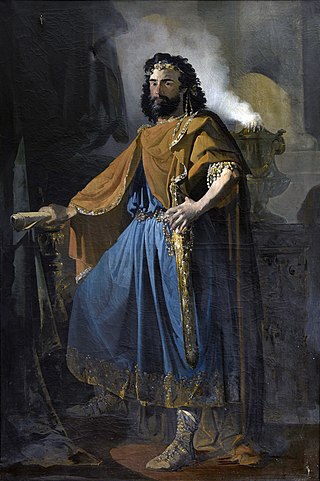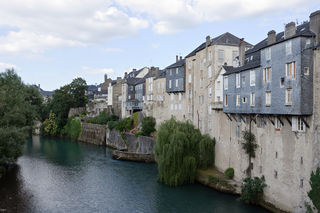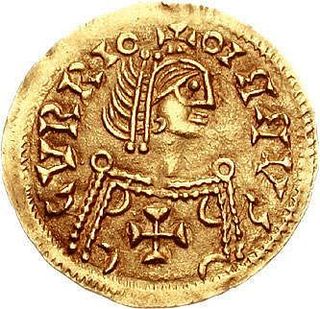Life
He was born in the 5th century at Lichos, in the lower valley of the River Saison, into a Catholic family.
During his youth, Catholics were persecuted by the Arian Euric, king of the Visigoths (466-485). Euric's successor, Alaric II (485-507), was tolerant towards them, permitting among other things the creation of Catholic bishoprics, including that of Oloron, of which Gratus was the first bishop. He took part in the Council of Agde in 506, [1] where 34 Catholic bishops of the Visigothic kingdom met under the chairmanship of Saint Caesarius of Arles.
In 507, the Visigoths were defeated by Clovis at the Battle of Vouillé. After the death of Clovis in 511, however, there was a still a strong Visigothic presence south of the Garonne (Aquitaine). Gratus is believed to have died at Jaca during this period, from where his body was retrieved and brought to its place of permanent rest in Oloron-Sainte-Marie.
His feast day is 11 October.
The Cathedral of Oloron-Sainte-Marie was decorated with five gilt and polychrome wooden panels depicting the scenes from the earth and heaven life of Saint Gratus

Alaric II was the King of the Visigoths from 484 until 507. He succeeded his father Euric as king of the Visigoths in Toulouse on 28 December 484; he was the great-grandson of the more famous Alaric I, who sacked Rome in 410. He established his capital at Aire-sur-l'Adour in Aquitaine. His dominions included not only the majority of Hispania but also Gallia Aquitania and the greater part of an as-yet undivided Gallia Narbonensis.

The Visigoths were a Germanic people united under the rule of a king and living within the Roman Empire during late antiquity. The Visigoths first appeared in the Balkans, as a Roman-allied barbarian military group united under the command of Alaric I. Their exact origins are believed to have been diverse but they probably included many descendants of the Thervingi who had moved into the Roman Empire beginning in 376 and had played a major role in defeating the Romans at the Battle of Adrianople in 378. Relations between the Romans and Alaric's Visigoths varied, with the two groups making treaties when convenient, and warring with one another when not. Under Alaric, the Visigoths invaded Italy and sacked Rome in August 410.
The 480s decade ran from January 1, 480, to December 31, 489.

Clovis was the first king of the Franks to unite all of the Franks under one ruler, changing the form of leadership from a group of petty kings to rule by a single king, and ensuring that the kingship was passed down to his heirs. He is considered to have been the founder of the Merovingian dynasty, which ruled the Frankish kingdom for the next two centuries. Clovis is important in the historiography of France as "the first king of what would become France."

Euric, also known as Evaric, son of Theodoric I, ruled as king (rex) of the Visigoths, after murdering his brother, Theodoric II, from 466 until his death in 484. Sometimes he is called Euric II.

Gaius Sollius Modestus Apollinaris Sidonius, better known as Sidonius Apollinaris, was a poet, diplomat, and bishop. Born into the Gallo-Roman aristocracy, he was son-in-law to Emperor Avitus and was appointed Urban prefect of Rome by Emperor Anthemius in 468. In 469 he was appointed Bishop of Clermont and he led the defence of the city from Euric, King of the Visigoths, from 473 to 475. He retained his position as bishop after the city's conquest, until his death in the 480s. He is venerated as a saint in the Catholic church, the Orthodox Church, and the True Orthodox Church, with his feast day on 21 August.

Septimania is a historical region in modern-day southern France. It referred to the western part of the Roman province of Gallia Narbonensis that passed to the control of the Visigoths in 462, when Septimania was ceded to their king, Theodoric II. During the Early Middle Ages, the region was variously known as Gallia Narbonensis, Gallia, or Narbonensis. The territory of Septimania roughly corresponds with the modern French former administrative region of Languedoc-Roussillon that merged into the new administrative region of Occitanie. In the Visigothic Kingdom, which became centred on Toledo by the end of the reign of Leovigild, Septimania was both an administrative province of the central royal government and an ecclesiastical province whose metropolitan was the Archbishop of Narbonne. Originally, the Goths may have maintained their hold on the Albigeois, but if so it was conquered by the time of Chilperic I. There is archaeological evidence that some enclaves of Visigothic population remained in Frankish Gaul, near the Septimanian border, after 507.

Oloron-Sainte-Marie is a commune in the southwestern French department of Pyrénées-Atlantiques.
This is a historical timeline of the Iberian Peninsula during the period of the post-Imperial kingdoms.

The arrondissement of Oloron-Sainte-Marie is an arrondissement of France in the Pyrénées-Atlantiques department in the Nouvelle-Aquitaine region. It has 155 communes. Its population is 72,504 (2016), and its area is 2,828.2 km2 (1,092.0 sq mi).
The Council of Agde was a regional synod held in September 506 at Agatha or Agde, on the Mediterranean coast east of Narbonne, in the Septimania region of the Visigothic Kingdom, with the permission of the Visigothic King Alaric II.
The First Council of Orléans was convoked by Clovis I, King of the Franks, in 511. Clovis called for this synod four years after his victory over the Visigoths under Alaric II at the Battle of Vouillé in 507. The council was attended by thirty-two bishops, including four metropolitans, from across Gaul, and together they passed thirty-one decrees. The bishops met at Orléans to reform the church and construct a strong relationship between the crown and the Catholic episcopate, the majority of the canons reflecting compromise between these two institutions.

Oloron Cathedral, now St. Mary's Church, is a Roman Catholic church and former cathedral located in the town of Oloron-Sainte-Marie, in the Pyrénées-Atlantiques département of France. It is in the Romanesque and Gothic architectural traditions.
Ruricius I was a Gallo-Roman aristocrat and bishop of Limoges from c. 485 to 510. He is one of the writers whose letters survive from late Roman Gaul, depicting the influence of the Visigoths on the Roman lifestyle. He should not be confused with his son-in-law, Saint Rusticus.

The Visigothic Kingdom, Visigothic Spain or Kingdom of the Goths occupied what is now southwestern France and the Iberian Peninsula from the 5th to the 8th centuries. One of the Germanic successor states to the Western Roman Empire, it was originally created by the settlement of the Visigoths under King Wallia in the province of Gallia Aquitania in southwest Gaul by the Roman government and then extended by conquest over all of Hispania. The Kingdom maintained independence from the Eastern Roman or Byzantine Empire, whose attempts to re-establish Roman authority in Hispania were only partially successful and short-lived.

Aren is a commune in the Pyrénées-Atlantiques department in the Nouvelle-Aquitaine region of south-western France. It is part of the urban area of Oloron-Sainte-Marie.

The former Roman Catholic Diocese of Oloron was a Latin rite bishopric in Pyrénées-Atlantiques department, Aquitaine region of south-west France, from the 6th to the 19th century.

Saint Galactorius was a bishop of Lescar in the early 6th century. His feast is celebrated on 27 July.

Agustius also known as Eusepius, was a sixth-century Catholic Bishop of Oloron in France.

Christianization of the Franks was the process of converting the pagan Franks to Catholicism during the late 5th century and early 6th century. It was started by Clovis I, regulus of Tournai, with the insistence of his wife, Clotilde and Saint Remigius, the bishop of Reims.














